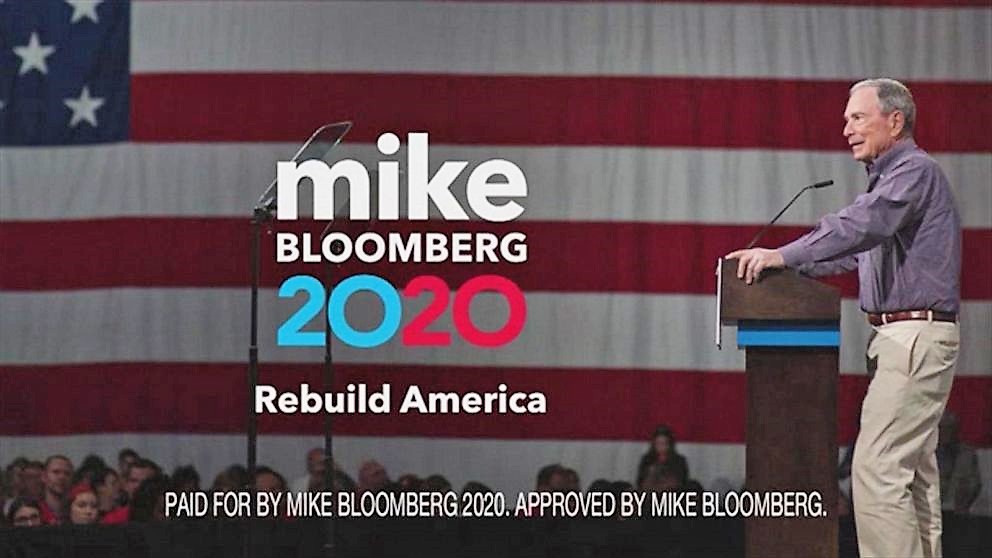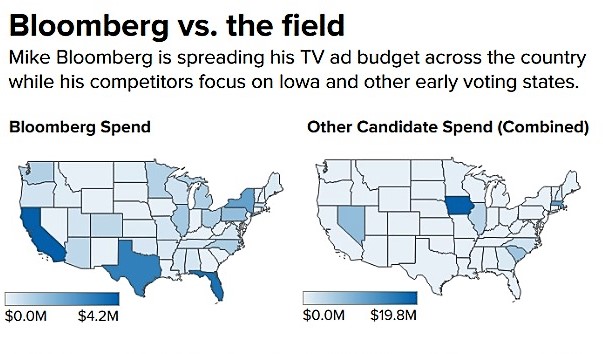Mike Bloomberg has made clear his intention to outspend the Democratic primary field, but his advertising strategy contrasts with most of his opponents.
While other Democratic candidates battle it out in early voting states such as Iowa, Bloomberg is focused on “Super Tuesday” states holding primaries on March 3, 2020.
The former New York City mayor entered the presidential race with a splash on Sunday, spending more than $35 million on ads that will air from November 25 through December 3, the most any candidate has ever spent for a single week, according to Advertising Analytics, a firm that tracks election ad buys.
An analysis of data provided by Advertising Analytics found that Bloomberg has put $13.2 million of those dollars to work on television ads across the 14 Super Tuesday states.
That sum is more than any other candidate’s total spend for the primary so far, and is nearly as much as the rest of the field combined.
In the early voting states of Iowa, New Hampshire, Nevada, and South Carolina, on the other hand, Bloomberg has spent only $21,480, less than any other candidate and a mere 0.06% of his total TV spend across the country.
The massive investment comes as Bloomberg and his aides argue that none of the other candidates are campaigning or putting enough resources into primary states that are scheduled beyond the first four.
These early primary contests are set for February, while the later state battles are far richer in delegates.
Bloomberg is also lavishing important swing states with some of his early ad buy.
“No one’s campaigning in the only [states] that matter: Michigan, Wisconsin, Pennsylvania, Florida, Arizona.
“Those are the only states that matter in the general election,” Bloomberg’s advisor Kevin Sheekey told MSNBC in a recent interview.
Bloomberg’s spending spree is separate from a $100 million digital ad buy where he intends to focus solely on attacking President Trump.
While Bloomberg has largely passed on early voting states, these areas have drawn 58% of the total TV ad spend from Bloomberg’s democratic opponents.
Every candidate other than Bloomberg and Hawaii Rep. Tulsi Gabbard has dedicated the majority of their TV spend to these regions, including the primary race front-runners.
Joe Biden (96% of total across Iowa and South Carolina) and Pete Buittigieg (83% across Iowa, New Hampshire, and South Carolina) are among the top spenders there by share of total spend.
Bloomberg is not shy about his belief that money can influence the political process.
At his first campaign event on Monday in Norfolk, Virginia — a Super Tuesday state — Bloomberg began his prepared remarks by mentioning his support of Virginia democrats who flipped the state government this month from Republican to Democratic control.
The gun control group Bloomberg backs, Everytown for Gun Safety, spent $2.5 million in Virginia’s elections this year.
With a net worth of more than $50 billion, Bloomberg will likely have more resources available than any other candidate throughout the campaign.
But even when controlling for total amount spent by analyzing the share of spend by state, Bloomberg’s Super Tuesday focus is clear.
He is spending a greater share of his TV budget than competitors in all but three of the 14 Super Tuesday states.
In total, 39% of Bloomberg’s TV spend to date is going toward ads in Super Tuesday states.
Among the front-runners, only Sanders (25% of his total TV spend) has committed a significant amount of his dollars to Super Tuesday states. Biden (0.5%), Buttigieg (1%), and Warren (0%) have yet to make a significant Super Tuesday investment.
Also unique in Bloomberg’s approach is his prioritization of national advertising.
He has spent 16% of his budget on national TV ads, and while Gabbard and fellow billionaire Tom Steyer (11%) have made this a focus, no other candidate has spent more than 3% nationally at this point in the race.



